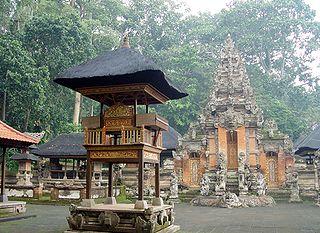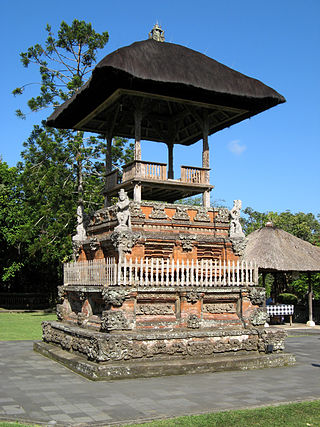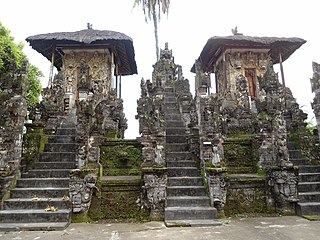Padangbai is a small coastal town in eastern Bali, Indonesia near Candidasa. It serves as a ferry port for travel to Lembar on Lombok, The Gilis and other of the Lesser Sunda Islands.

Besakih Temple is a pura complex in the village of Besakih on the slopes of Mount Agung in eastern Bali, Indonesia. It is the most important, largest, and holiest temple of Balinese Hinduism, and one of a series of Balinese temples. Perched nearly 1000 meters up the side of Gunung Agung, it is an extensive complex of 23 separate but related temples with the largest and most important being Pura Penataran Agung. The temple is built on six levels, terraced up the slope. The entrance is marked by a candi bentar, and beyond it, the Kori Agung is the gateway to the second courtyard.

Bangli Regency is the one and only landlocked regency (kabupaten) of Bali, Indonesia.

A candi is a Hindu or Buddhist temple in Indonesia, mostly built during the Zaman Hindu-Buddha or "Hindu-Buddhist period" between circa the 4th and 15th centuries.

Tampaksiring is a town in central Bali, Gianyar Regency, Indonesia. As of the 2010 census, the area was 42.63 km2 and the population was 45,818; the latest official estimate is 48,740. It is the home to the Gunung Kawi Temple and archaeological site and the Senang Hati Foundation.
The Purbakala Archaeological Museum or Gedong Arca Museum is a museum located in Bedulu on Bali, Indonesia.

The Moon of Pejeng, also known as the Pejeng Moon, in Bali is the largest single-cast bronze kettle drum in the world. and "the largest known relic from Southeast Asia's Bronze Age period." It is "considered highly sacred by local people." It is thought to be a relic of early rice cultivation rituals.

Pejeng is a village in Bali, Indonesia, in the Petanu River valley. It is a bit east of Ubud in Gianyar Regency. It is home to the Moon of Pejeng, the largest single-cast bronze kettle drum in the world. Pejeng is a rural area with extensive, and ancient, irrigated rice cultivation.

Pura Ulun Danu Beratan, or Pura Bratan, is a major Hindu Shaivite temple in Bali, Indonesia. The temple complex is on the shores of Lake Beratan in the mountains near Bedugul. The water from the lake serves the entire region in the outflow area; downstream there are many smaller water temples that are specific to each irrigation association (subak).

Pura Ulun Danu Batur is a Hindu Balinese temple located on the island of Bali, Indonesia. As one of the Pura Kahyangan Jagat, Pura Ulun Danu Batur is one of the most important temples in Bali which acted as the maintainer of harmony and stability of the entire island. Pura Ulun Danu Batur represents the direction of the North and is dedicated to the god Vishnu and the local goddess Dewi Danu, goddess of Lake Batur, the largest lake in Bali. Following the destruction of the original temple compound, the temple was relocated and rebuilt in 1926. The temple, along with 3 other sites in Bali, form the Cultural Landscape of Bali Province which was inscribed as a World Heritage Site by UNESCO in 2012.

Tirta Empul temple is a Hindu Balinese water temple located near the town of Tampaksiring, Bali, Indonesia. The temple compound consists of a petirtaan or bathing structure, famous for its holy spring water, where Balinese Hindus go to for a ritual purification called Melukat. The temple pond has a spring which gives out fresh water regularly, which Balinese Hindus consider to be holy or amritha. Tirta Empul means Holy Spring in Balinese.

A Pura is a Balinese Hindu temple, and the place of worship for adherents of Balinese Hinduism in Indonesia. Puras are built following rules, style, guidance, and rituals found in Balinese architecture. Most puras are found on the island of Bali, where Hinduism is the predominant religion; however many puras exist in other parts of Indonesia where significant numbers of Balinese people reside. Mother Temple of Besakih is the most important, largest, and holiest temple in Bali. Many Puras have been built in Bali, leading it to be titled "the Island of a Thousand Puras".

Pura Luhur Batukaru is a Hindu temple in Tabanan, Bali, Indonesia. Located on the southern slope of Mount Batukaru, Bali's second-highest volcano, the temple is one of nine kayangan jagat meant to protect Bali from evil spirits. Originally built during the 11th century, Pura Luhur Batukaru was dedicated to the ancestors of the rajas of Tabanan. It was destroyed in 1604, but rebuilt in 1959. The temple's most important shrine is a 7-tiered meru dedicated to Mahadewa, the God of Mount Batukaru.
Bedulu, also spelt Bedahulu or Bedaulu, is a historical site in Bali, Indonesia. It is situated about two kilometer to the west of today Gianyar town.

The bale kulkul or bale kul-kul is a Balinese pavilion where a slit-log drum is placed. It is essentially a drum tower or a watch tower. A bale kulkul can has a civic function, such as those used in villages as a mean of communication; or for religious function, an integral part of Balinese temple architecture.
Pura Griya Sakti is a Balinese Hindu temple located in the village of Manuaba, Kenderan administrative village, Tegalalang subdistrict, Gianyar Regency, Bali. The district is known for its woodcarving and its terraced rice field. The small village of Manuaba is about 4 km north of Kenderan or about 2.5 km southwest of the town of Tampaksiring with its famed Gunung Kawi temple. Pura Griya Sakti is the main temple of a powerful Brahman caste in the area.
Pura Lempuyang Luhur is one of the oldest and the most revered temple in Bali, Indonesia. It is located on Mount Lempuyang or Gamongan Hill, Bunutan village, Abang subdistrict, Karangasem, east Bali, around 10 kilometres north from Amlapura, the capital of Karangasem.

Pura Penataran Agung Lempuyang is a Balinese Hindu temple or pura located in the slope of Mount Lempuyang in Karangasem, Bali. Pura Penataran Agung Lempuyang is considered as part of a complex of pura surrounding Mount Lempuyang, one of the highly regarded temples of Bali. The temples of Mount Lempuyang, represented by the highest pura at the peak of Mount Lempuyang, Pura Lempuyang Luhur, is one of the Sad Kahyangan Jagad, or the "six sanctuaries of the world", the six holiest places of worship on Bali.

Pura Dalem Segara Madhu also known as Pura Dalem Jagaraga is a northern Balinese Hindu temple or pura located in the village of Jagaraga, Buleleng in northern Bali. It is about 11 km east of Singaraja. The village of Jagaraga is known historically as the place where the Dutch colonial government witnesses puputan or Balinese mass-suicide following their military attack on the kingdom of Bali in 1849. Pura Dalem Segara Madhu is known for its intensive wall decoration typical of northern Balinese architecture and for its unique western-influenced reliefs featuring early 20th-century airplanes and automobiles.


















